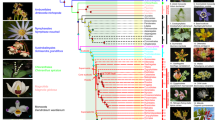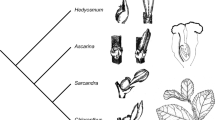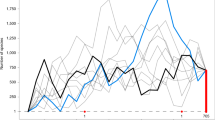Abstract
The ancestral angiosperm is commonly interpreted as an arborescent to shrubby magnolialean with large, multiparted, complex flowers. We examined this hypothesis using a phylogenetic analysis of new and reevaluated characters polarizabled with outgroup comparison. Our cladistic analysis of basal angiosperms placed the nonmagnolialeanChloranthaceae andPiperaceae at the bottom of the tree. We further inferred the probable ancestral states of characters not polarizable with outgroup comparison by examining their distribution among taxa at the base of our cladogram. The sum of ancestral character states suggests that the protoangiosperm was a diminutive, rhizomatous to scrambling perennial herb, with small, simple flowers.
Similar content being viewed by others
References
Archangelsky, S., Brett, D. W., 1961: Studies of Triassic fossil plants from Argentina, I.Rhexoxylon from the Ischigualasto Formation. — Roy. Soc. London Philos. Trans.244: 1–19.
Ayensu, E. S., 1972:Dioscoreales. — London: Oxford University Press.
Baas, P., Gregory, M., 1985: A survey of oil cells in the dicotyledons with comments on their replacement by and joint occurrence with mucilage cells. — Israel J. Bot.34: 167–186.
Behnke, H.-D., 1988: Sieve-element plastids, phloem protein, and evolution of flowering plants: III.Magnoliidae. — Taxon37: 699–732.
Burger, W. C., 1981: Heresy revived: the monocot theory of angiosperm origin. — Evol. Theory5: 189–225.
Carlquist, S., 1987: Presence of vessels in wood ofSarcandra (Chloranthaceae): comments on vessel origins in angiosperms. — Amer. J. Bot.74: 1765–1771.
Conover, M., 1983: The vegetative morphology of the reticulate-veinedLiliiflorae. — Telopea2: 401–442.
Cornet, B., 1986: The reproductive structures and leaf venation of a Late Triassic angiosperm,Sanmiguelia lewisii. — Evol. Theory7: 231–309.
, 1989a: Late Triassic angiosperm-like pollen from the Richmond Rift Basin of Virginia, U.S.A. — Palaeonotgraphica Abt.B 213: 37–87.
, 1989b: The reproductive morphology and biology ofSanmiguelia lewisii, and its bearing on angiosperm evolution in the Late Triassic. — Evol. Trends Pl.3: 25–51.
Crane, P. R., 1985: Phylogenetic analysis of seed plants and the origin of angiosperms. — Ann. Missouri Bot. Gard.72: 716–793.
, 1988: Major clades and relationships in the “higher” gymnosperms. — InBeck, C. B., (Ed.): Origin and evolution of gymnosperms, pp. 218–272. — New York: Columbia University Press.
,Upchurch, G. R., Jr., 1987:Drewria potomacensis gen. et sp. nov., an early Cretaceous member ofGnetales from the Potomac Group of Virginia. — Amer. J. Bot74: 1722–1736.
Cronquist, A., 1981: An integrated system of classification of the angiosperms. — New York: Columbia University Press.
, 1988: The evolution and classification of flowering plants, 2nd edn. — Bronx, New York: The New York Botanical Garden.
Dahlgren, R. M. T., Clifford, H. T., Yeo, P. F., 1985: The families of monocotyledons. — Berlin: Springer.
Davis, G. L., 1966: Embryology of the angiosperms. — New York: Wiley.
Donoghue, M. J., Doyle, J. A., 1989: Phylogenetic analysis of angiosperms and the relationships ofHamamelidae. — InCrane, P. R., Blackmore, S., (Eds.): Evolution, systematics, and fossil history of theHamamelidae, pp. 17–45. — Oxford: Clarendon Press.
Doyle, J. A., Donoghue, M. J., 1986: Seed plant phylogeny and the origin of angiosperms: an experimental cladistic approach. — Bot. Rev.52: 321–431.
, 1976: Pollen and leaves from the mid-Cretaceous Potomac Group and their bearing on early angiosperm evolution. — InBeck, C. B., (Ed.): Origin and early evolution of angiosperms, pp. 139–206. — New York: Columbia University Press.
Ehrendorfer, F., 1976: Evolutionary significance of chromosomal differentiation patterns in gymnosperms and primitive angiosperms. — InBeck, C. B., (Ed.): Origin and early evolution of angiosperms, pp. 220–240. — New York: Columbia University Press.
Ehrendorfer, F., 1986: Chromosomal differentiation and evolution in angiosperm groups. — InIwastsuki, K., Raven, P. H., Bock, W. J., (Eds.): Modern aspects of species, pp. 59–86. — Tokyo: University of Tokyo Press.
Erdtman, G., 1969: Handbook of palynology. — Copenhagen: Munksgaard.
Foster, A. S., 1972: Venation patterns in the leaves ofEphedra. — J. Arnold Arbor.53: 364–385.
Friedman, W. E., 1990: Double fertilization inEphedra, a nonflowering seed plant: its bearing on the origin of angiosperms. — Science247: 951–954.
Friis, E. M., Crane, P. R., Pedersen, K. P., 1988: Floral evidence for Cretaceous chloranthoid angiosperms. — Nature320: 163–164.
Gifford, E. M., Foster, A. S., 1989: Morphology and evolution of vascular plants. 3rd edn. — New York: Freeman.
Gregory, M., Baas, P., 1989: Review. A survey of mucilage cells in vegetative organs of the dicotyledons. — Israel J. Bot.38: 125–174.
Hamby, R. K., Zimmer, E. A., 1990: Ribosomal RNA as a phylogenetic tool in plant systematics. — InSoltis, D. E., Soltis, P., Doyle, J. J., (Eds.): Plant molecular systematics. — Routledge: Chapman and Hall.
Harris, T. M., 1964: The Yorkshire Jurassic flora. II.Caytoniales, Cycadales, andPteridosperms. — London: British Museum (Natural History).
, 1969: The Yorkshire Jurassic flora. III.Bennettitales. — London: British Museum (Natural History).
, 1971: The stem ofCaytonia. — Geophytology1: 23–29.
Hickey, L. J., Doyle, J. A., 1977: Early Cretaceous fossil evidence for angiosperm evolution. — Bot. Rev.43: 3–104.
, 1989: Reexamination of leaf architectural characters of basal angiosperms and their sister-groups: implications for the origin and relationships of angiosperms. — Amer. J. Bot.76: 245.
, 1991: The leaf architecture ofTicodendron and the application of foliar characters in discerning its relationships. — Ann. Missouri Bot. Gard.78: 105–130.
, 1975: The bases of angiosperm phylogeny: vegetative morphology. — Ann. Missouri Bot. Gard.62: 538–589.
Jain, R. K., Delevoryas, T., 1967: A middle Triassic flora from the Cacheuta Formation, Minas de Petroleo, Argentina. — Palaeontology10: 564–589.
Kaplan, D. R., 1973: The monocotyledons: their evolution and comparative biology. VII. The problem of leaf morphology and evolution in the monocotyledons. — Quart. Rev. Biol.48: 437–457.
Kondo, K., Na, H., Gu, Z., Fan, Q., Xia, L., 1987: A karyomorphological study in four species ofAsarum from Yunnan, China. — Kromosomo2: 1495–1501.
Levin, G., 1986: Systematic foliar morphology ofPhyllanthoideae (Euphorbiaceae). III. Cladistic analysis. — Syst. Bot.11: 515–530.
Lidgard, S., Crane, P. R., 1990: Angiosperm diversification and Cretaceous floristic trends: a comparison of palynofloras and leaf macrofloras. — Paleobiology16: 77–93.
Loconte, H., Estes, J. R., 1989; Phylogenetic systematics ofBerberidaceae andRanunculales (Magnoliidae). — Syst. Bot.14: 565–579.
, 1990: Cladistics of theSpermatophyta. — Brittonia42: 197–211.
Maddison, W. P., Donoghue, M. J., Maddison, P. R., 1984: Outgroup analysis and parsimony. — Syst. Zool.33: 83–103.
Maheshwari, H. K., 1972: Permian wood from Antarctica and revision of some Lower Gondwana wood taxa. — Palaeontographica Abt. B138: 1–43.
Maheshwari, P., Vasil, V., 1961:Gnetum. — New Dehli: Council of Scientific and Industrial Research.
Martens, P., 1971: Les Gnetophytes. — Berlin: Gebrüder Borntraeger.
Meeuse, A. D. J., 1987: All about angiosperms. — Delft: Edburon.
Metcalfe, C. R., 1987: Anatomy of the dicotyledons. 2nd edn. — Oxford: Clarendon Press.
, 1950: Anatomy of the dicotyledons. — Oxford: Clarendon Press.
Miller, C. N., Jr., 1988: The origin of modern conifer families. — InBeck, C. B., (Ed.): Origin and evolution of gymnosperms, pp. 448–486. — New York: Columbia University Press.
Pant, D. D., Singh, R. S., 1974: On the stem and attachment ofGlossopteris andGangamopteris leaves. Part II. Structural features. — Palaeontographica Abt. B147: 42–73.
Pearson, H. H. W., 1929:Gnetales. — Cambridge: Cambridge University Press.
Pigg, K. B., 1990a: Anatomically preservedGlossopteris foliage from the central Transantarctic Mountains. — Rev. Palaeobot. Palynol.66: 105–127.
, 1990b: Anatomically preservedDicroidium foliage from the central Transantarctic Mountains. — Rev. Palaeobot. Palynol.66: 129–145.
, 1990: PermineralizedGlossopteris andDicroidium from Antarctica. — InTaylor, T. N., Taylor, E. L., (Eds.): Antarctic paleobiology its role in the reconstruction of Gondwana, pp. 164–172. — New York: Springer.
Poethig, R. S., Sussex, I. M., 1985: The cellular parameters of leaf development in tobacco: a clonal analysis. — Planta165: 170–184.
Poethig, S., 1984: Cellular parameters of leaf morphogenesis in maize and tobacco. — InWhite, R. A., Dickison, W. C., (Eds.): Contemporary problems in plant anatomy, pp. 235–259. — Orlando: Academic Press.
Queiroz, K., De, 1987: Phylogenetic systematics of Iguanine lizards. — Univ. Calif, Publ. Zool.118.
Rao, A. R., 1943: The structure and affinities ofTaeniopteris spatualata McCl. — Proc. Natl. Acad. Sci. India13: 333–355.
Retallack, G. J., Dilcher, D. L., 1988: Reconstructions of selected seed ferns. — Ann. Missouri Bot. Gard.75: 1010–1057.
Rodin, R. J., 1953: Seedling morphology ofWelwitschia. — Amer. J. Bot.40: 371–378.
Sahni, B., 1948: ThePentoxyleae: A new group of Jurassic gymnosperms from the Rajmahal Hills of India. — Bot. Gaz.110: 47–80.
Srivastava, B. P., 1945: Silicified plant remains from the Rajmahal series of India. — Proc. Natl. Acad. Sci. India15 B: 190–211.
Stebbins, G. L., 1974: Flowering plants: evolution above the species level. — Cambridge, MA: The Belknap Press of Harvard University Press.
Steeves, M. W., Barghoorn, E. S., 1959: The pollen ofEphedra. — J. Arnold Arbor.40: 221–259.
Stewart, W. N., 1983: Plaeobotany and the evolution of plants. — Cambridge: Cambridge University Press.
Sussex, I. M., Taylor, D. W., 1989: The origin and evolution of leaves. — Current Topics Pl. Biochem. Physiol.118: 161–167.
Swofford, D. L., 1985: PAUP Version 2.4. — Champaign, IL: Illinois Natural History Survey.
Takhtajan, A. L., 1980: Outline of the classification of flowering plants (Magnoliophyta). — Bot. Rev.46: 225–359.
Taylor, D. W., 1991: Angiosperm ovules and carpels: their characters and polarities, distribution in basal clades and structural evolution. — Postilla208: 1–40.
, 1990: An Aptian plant with attached leaves and flowers: implications for angiosperm origin. — Science247: 702–704.
Taylor, T. N., 1973: A consideration of the morphology, ultrastructure, and multicellular microgametophyte ofCycadeoidea dacotensis pollen. — Rev. Palaeobot. Palynol.16: 157–164.
, 1987: The ultrastructure of fossil gymnosperm pollen. — Bull. Soc. Bot. France134: 121–140.
, 1984: The ultrastructure of Mesozoic pollen:Pteruchus dubius (Thomas)Townrow. — Rev. Palaeobot. Palynol.41: 319–327.
Townrow, J. A., 1965: A new member of theCorystospermaceae Thomas. — Ann. Bot.29: 495–511.
Walker, J. W., 1976: Comparative pollen morphology and phylogeny of the ranalean complex. — InBeck, C. B., (Ed.): Origin and early evolution of angiosperms, pp. 241–299. — New York: Columbia University Press.
West, W. C., 1969: Ontogeny of oil cells in the woodyRanales. — Bull. Torrey Bot. Club96: 329–344.
Wieland, G. R., 1906: American fossil cycads. — Washington, DC: Carnegie Institution of Washington.
Zavada, M. S., Crepet, W. L., 1986: Pollen grain wall structure ofCaytonanthus arberi (Caytoniales). — Pl. Syst. Evol.153: 259–264.
Zimmer, E. A., Hamby, R. K., Arnold, M. L., Leblanc, D. A., Theriot, E. C., 1989: Ribosomal RNA phylogenies and flowering plant evolution. — InFernholm, B., Bremer, K., Jornvall, H., (Eds.): The hierarchy of life: molecules and morphology in phylogenetic analysis, pp. 205–214. — Amsterdam: Elsevier.
Author information
Authors and Affiliations
Rights and permissions
About this article
Cite this article
Taylor, D.W., Hickey, L.J. Phylogenetic evidence for the herbaceous origin of angiosperms. Pl Syst Evol 180, 137–156 (1992). https://doi.org/10.1007/BF00941148
Received:
Revised:
Accepted:
Issue Date:
DOI: https://doi.org/10.1007/BF00941148




